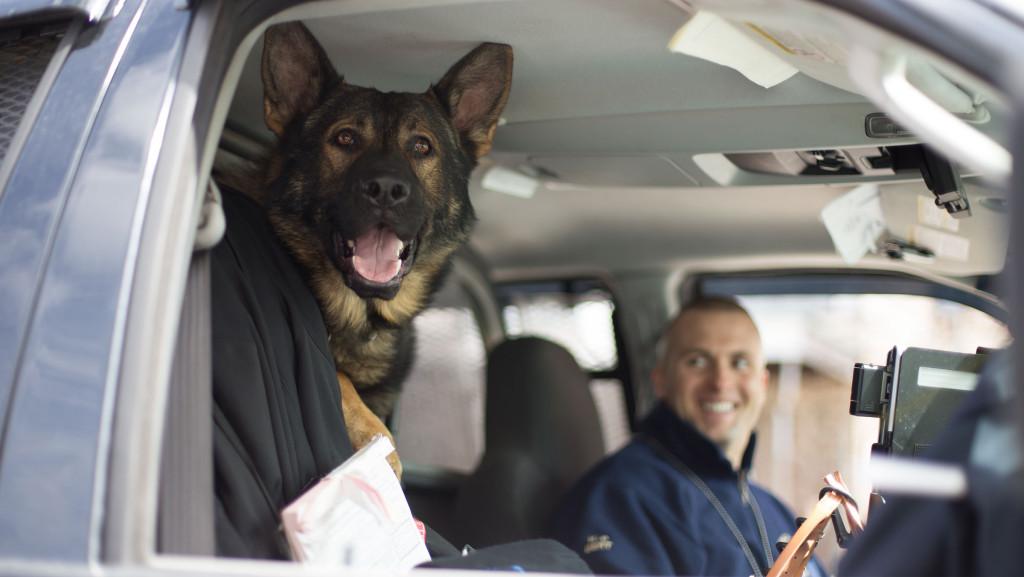The dog in the car
The high on March 7 is a bitter 27 degrees, and on Meadow Street the wind is still — so much so that the receipts from a nearby credit union’s ATM lie, unmoving, on the concrete. Coming up the block, a father and his daughter are walking, the little girl’s jacket a bright blue explosion in the gray of the overcast afternoon.
From a side street, a hulking, black-and-white police cruiser pulls up alongside the walkers. Its side, in thick red letters, reads, “CAUTION: K-9.” The cruiser stops just in front of the two, and Officer Pat Kimmich lowers the window.
“Hey,” he says to the pair. “Do you guys want some stickers?”
He reaches up toward the sun visor, where a long sheet of stickers is wedged between it and the roof. There are several circular decals, each one showing a stoic German shepherd staring into the distance. Kimmich tears off a few of these and hands them out through the window.
During this exchange, a nose pokes through the small window between the cruiser’s driver and passenger seat. Then a pair of ears and a taffy-pink tongue. Then, suddenly, a pair of massive, brown paws. Bert, Ithaca Police Department’s one and only K-9 unit, appears from the backseat, peering over the officer’s shoulder toward the people outside.
Kimmich smiles and looks back at the dog. The man, who, unlike his daughter, is tall enough to see into the cabin, is arching his neck to to catch a quick glimpse.
Just a few moments later, Kimmich has exited the car and opened the backdoor of the cruiser, and the little, blue-jacketed girl is running her hand over Bert’s tremendous cranium, all the while gawking at his massive paws.
“What is he?” the man asks Kimmich. “He’s a German Shepherd?”
Kimmich confirms. He’s leaning up against the car, resting his shoulder on the driver-side door, leash in hand, watching as the pair meets Bert.
“That’s my favorite type of dog,” the little girl says. She’s smiling joyfully, looking up at the dog, who, from the car seat, towers over her. There’s no fear to be found here, even though her hand barely wraps one of the dog’s always-standing ears.
They all talk for a few minutes until the two bid farewell to Bert and Kimmich, returning to their chilly trek through downtown Ithaca. Kimmich shuts Bert’s door and returns to the driver’s seat. Bert has his head poked through the window again, watching Kimmich’s hand as he nestles the sheet of stickers back into the sun visor. The cruiser pulls back onto Meadow street, and Bert returns to the back, staring out the window as downtown Ithaca rushes past.
“I like to do that when I can,” Kimmich says, driving past the man and the blue-jacketed girl. Kimmich gives a quick, farewell wave, and they return it, waving back and soon vanishing into a blue speck in the side mirror.
“Those are perfect opportunities,” Kimmich continues. “You know, it’s that simple, it’s that fast. Somebody who may have just walked by, may have thought I’m an asshole IPD cop. And now he’s like, ‘You know what, you just gave my daughter a sticker, and talked.’”
[left_half]
Before Bert
When Kimmich was young, before he ever cut his hair to the scalp or paid bills or strapped a handgun to his belt, he was fascinated with law enforcement: the cars, the sirens — the helping. He reckons it might have been his childhood toys, be it the matchbox cars or the action figures, that sparked this intrigue. Nevertheless, as he grew older and began to consider the answer to “What do you want to be when you grow up,” this youthful enthusiasm quickly began to find its way into the realm of possibility.
“You know, when you get into middle school, when they start talking about occupations, law enforcement drew my interest,” Kimmich said, “I always thought law enforcement was a job to help people.”
And so he followed this gut reaction. Growing up in Dryden, New York, he shadowed the local police, finding his way into the passenger seat of patrol cars, each time further convincing himself it was the driver’s seat — the officer’s seat — that he was meant to occupy.
“I always loved going. I loved hanging out with the officers … just watching what they do,” he said. “I thought the world of them.”
But getting there would take time: a degree in criminal justice at Tompkins Cortland Community College, an internship with the Cortland City Police Department, training in the police academy, patrol, SWAT teams, numerous exams. By the time he reached the Ithaca Police Department, as officer 157, it was 2009. But it would be five years — five years until March 17, 2014, when Kimmich’s phone vibrates. It’s a text message from Investigator Fred Myers, a former K-9 handler.
On the screen, a brown German shepherd stared, with golden eyes, into the camera. A few hours afterward, Kimmich was greeted at his home by Myers and the very same dog.
[/left_half][right_half]
Before Kimmich
It’s tough to know much about Bert before he made it into the United States. In fact, for those who don’t speak Czech, it’d be hard to know anything about him at all: his passport, his files, his entire history, are all in the language, and he couldn’t explain them to anyone if he tried. Albert “Bert” Stanios is a purebred German shepherd, born March 26, 2013, in Kuncice, a village in Ostrava, Czech Republic.
He is “vlkoseda,” Czech for sable : a sandy, leather, saddle-brown color, which slowly fades to black. This pattern wraps all of his body, his jaw and snout darkened. His haunches, peppered. His legs, bronze. And then, there are his eyes: In his blackened face, two bright splashes of brown outline his eyes, each one almost golden — smart, inquisitive and ardently alert.
His time in Kuncice was short. He had only a fleeting year of training, before he, a puppy, crossed over the Atlantic, eventually arriving at Shallow Creek Kennels, in Sharpsville, Pennsylvania, about an hour outside of Pittsburgh.
Bert’s first days were those of travel — it was here he’d stay, but only for a few weeks.
One day, two men visited the kennels. They looked at many of the kennel’s dogs, and eventually, they came upon Bert. At some point during all of this, they snapped a photo of him in his kennel, and sent it out through a text message.
Several miles away, back in Ithaca, Kimmich would pick up his phone and see a young, sable German shepherd, just under a year old, framed on the screen.
Later on March 17, 2014, that same dog, with those same two men, walked up to Kimmich’s home.
[/right_half]
The garage door opened, and they all walked inside.
Getting Bert
Getting to this point, however, was a process.
It’s the summer of 2013. Kimmich has been working on this PowerPoint for some time now: “Ithaca Police Department K-9 Team Proposal.” He wanted a K-9 program for a few years before this and hoped to bring to the station what he saw as an essential tool for officer safety. This was the presentation that would, hopefully, make it happen — the one that would give him the green light to seek out funding.
First, however, he had to make it through these 14 slides.
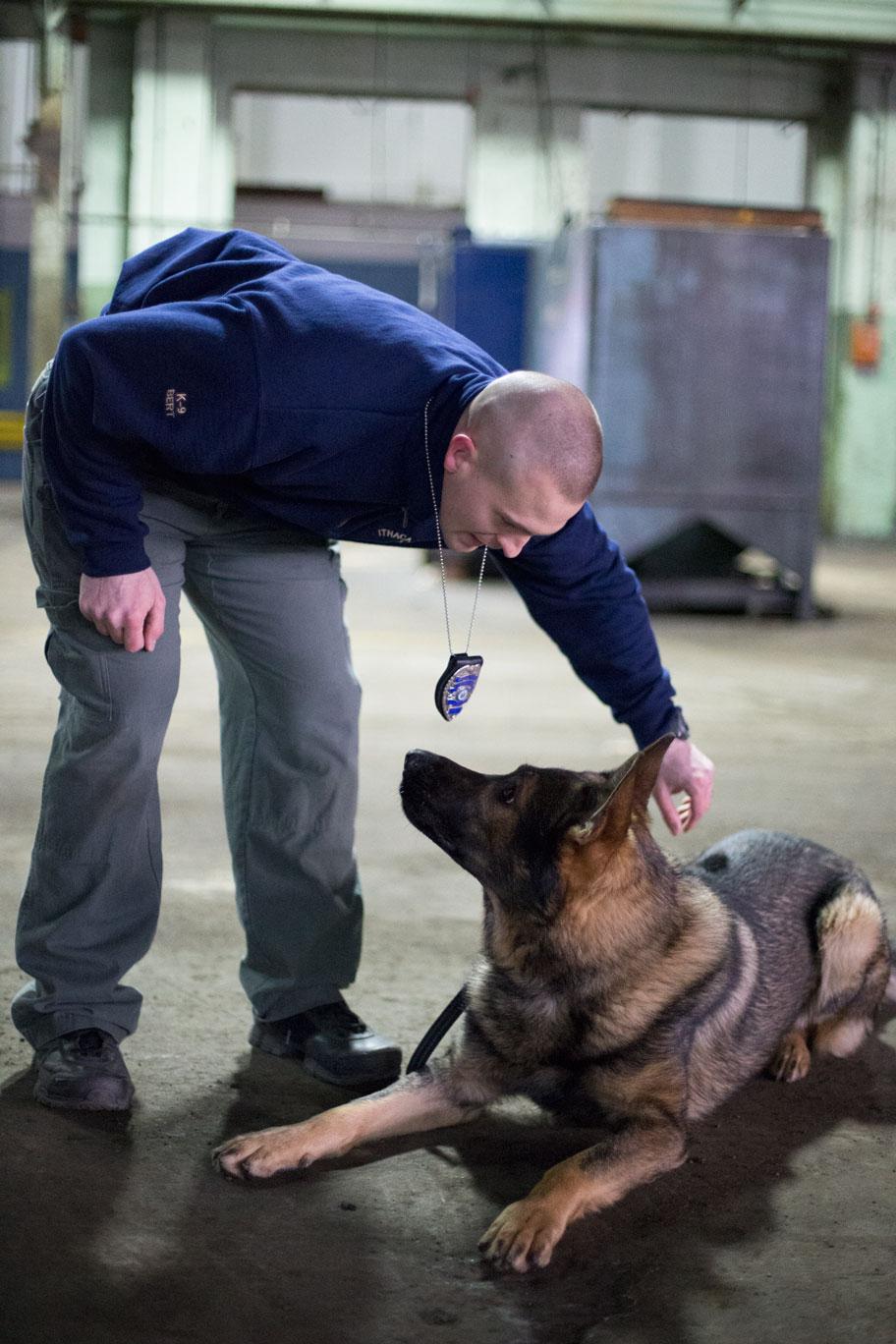
Bert lies down at Kimmich’s command March 28. Kimmich said he wanted to revive the IPD’s K-9 program to help increase officer safety.
“I didn’t know what I was doing,” Kimmich said. “I had no idea how to do it. I had no idea what I was doing. I knew what I wanted to do, but had no information about it, knew nothing about it, had no experience with it, didn’t even know who to call. I remember opening up a Microsoft Word document, putting the title up and ‘Presented by,’ and that was it.”
Even more daunting, the IPD had been without a K-9 unit for almost 10 years, and with little talk of it since, the situation showed very few signs of changing. The reason for this absent asset is cloudy. Kimmich theorizes past management may have had a role in it but said it’s hard to say. All he knew was that if he wanted to get a K-9 unit back in the station, he had to cover every variable of the equation in these 14 slides.
In the days before his proposal, Kimmich practiced with peers, going over the slides. He was, admittedly, nervous leading up to the presentation.
“I’m the type of person that gets nervous with that type of stuff anyway,” he said. “I feel like I get that extra bit of anxiety in myself. And do I calm down eventually? Sure, but you know, you start off and your voice is a little shaky.”
Despite any jabs he may make at himself, Kimmich’s presentation went, as he put it, “surprisingly well,” and ultimately, he got what he wanted. On June 24, 2013, he was given permission from Chief of Police John Barber to search for funding for the project. If he could find the cash to do it, the K-9 unit was on track to return.
Welcoming Bert
It’s June 23, 2014, and Bert is staring straight up, his back arched, his ears perked at attention, his two, golden eyes staring directly into the face of Ithaca Mayor Svante Myrick. This is the K-9’s moment: his swearing in, the official declaration of his membership with the Ithaca police force. It is by the grace of a Homeland Security Grant, along with public donations, that Bert finds himself at this point, soon to be Ithaca’s lone police K-9.
Bert is, as all are when sworn into law enforcement, asked by the mayor to give oath to the force. Bert, who has, for most of the presentation, been trying to stand on the podium, seems eager to take on this seemingly impossible task, though his lacking human speech won’t stop him. And he will: On Kimmich’s command, and much to the officer’s delight, Bert delivers with gusto a spry, stifled bark.
“It was not a real loud bark, but it’s just enough to confirm to the mayor, ‘I’m willing, I’m able,’” Kimmich said. “I didn’t know that the bark was going to work or not. I wanted it to, just because I thought it was going to be a kind of cool little touch, and everybody loved it.”
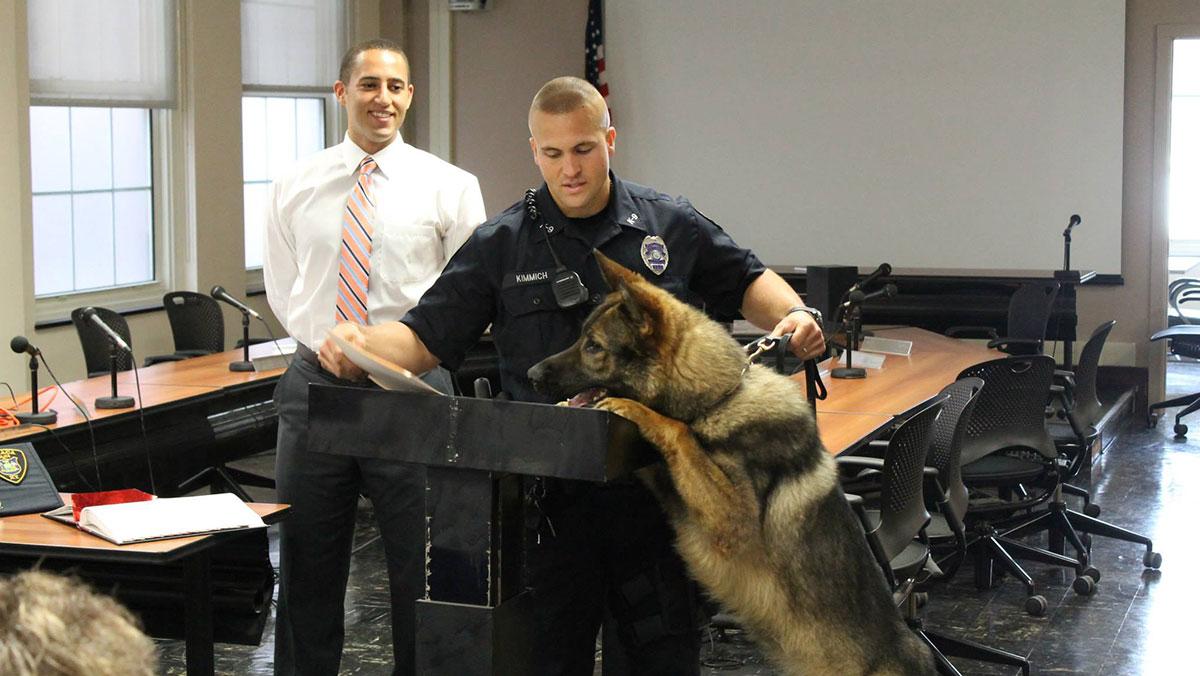
Bert inspects the podium during his swearing in June 23, 2014, while Ithaca Mayor Syvante Myrick watches over the event.
Myrick smiles, moving back, buckling over — surprised, and like most in the room, as the applause would indicate, delighted. On the table, a shield-shaped pendant lies in a display case. “Bert,” it reads, engraved into its chrome surface. It’s brilliantly shiny, so shiny it almost looks fake nestled into Bert’s fur as it is slipped over his ears and onto his neck.
After the ceremony, Kimmich will take the pendant and tie it to the handle above his driver-side window. There it hangs, visible through the window, rocking as the cruiser moves, in plain view for the whole of Ithaca, or perhaps, just Kimmich, to see.
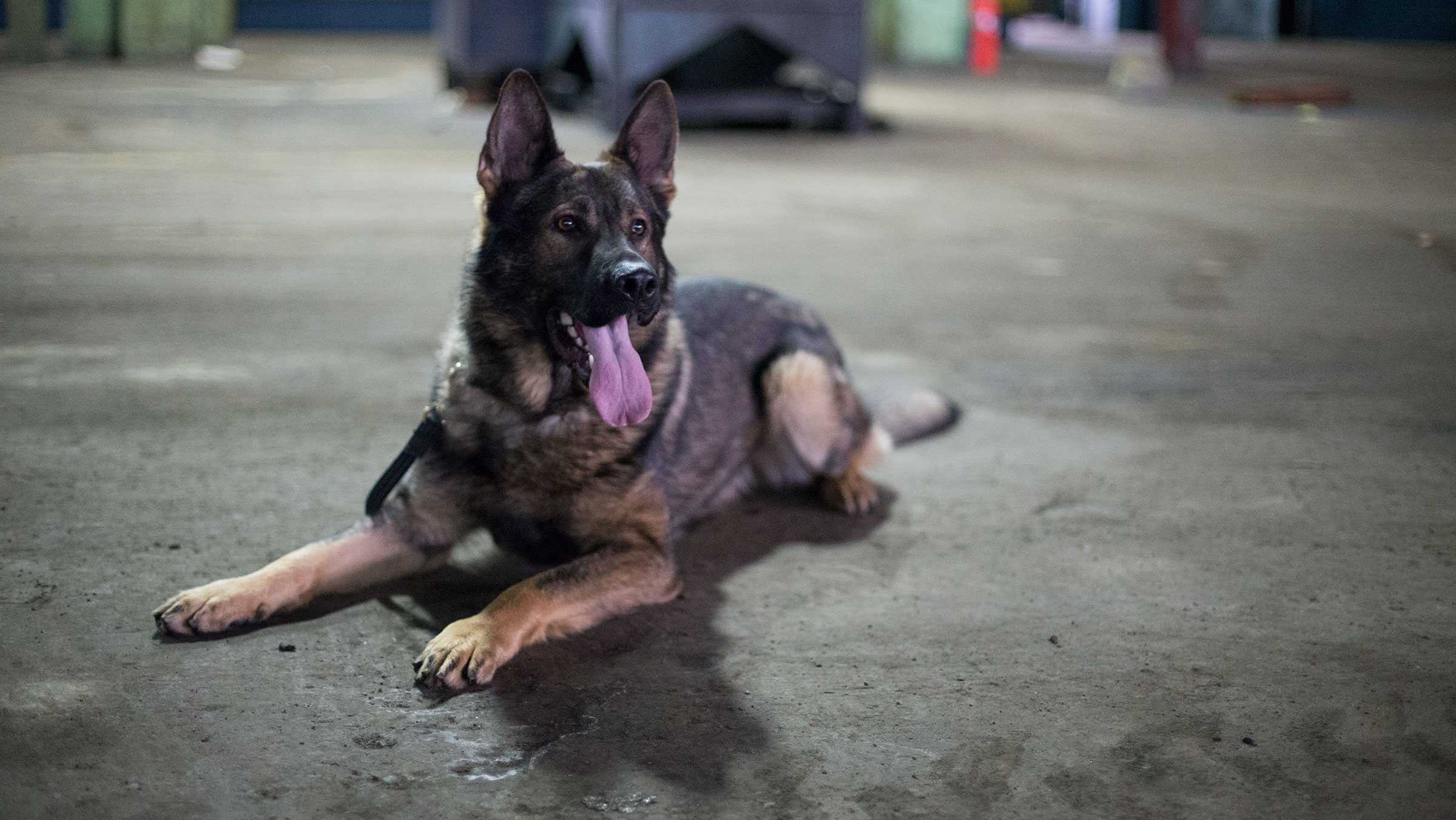
Bert is a dual-purpouse K-9 unit, which means he is capable of sniffing out live explosive components while also boasting tracking and apprehension abilities. Kimmich said Bert is currently the only K-9 unit in the county that holds this designation.
Bert, the Bridge
Kimmich will often admit it: Bert has more charisma than his two-legged counterparts, though this won’t surprise many. Bert will joyfully inspect any new face, oftentimes leaping up on people, oblivious to his surprising height.
Though this is all for the better. Bert’s penchant for making friends makes it easier for Kimmich, as an officer, to engage with the community: a wagging, welcoming new asset to the IPD force.
As Bert’s handler, Kimmich doesn’t take this role lightly. Scrolling through Bert’s logs in the police computers, this is obvious: dozens of visits to schools, barber shops and more are all logged, listed among Bert’s more official, law enforcement duties, including perimeter checks, building searches and more.
Notable among these visits occurred in November 2014, when Kimmich and Bert visited the Ithaca Youth Bureau and were welcomed into a meeting of the bureau’s Big Brothers Big Sisters. During the visit, both kids and adults were given the opportunity to acquaint themselves with Bert and ask Kimmich questions regarding the K-9 unit. Youth Program Leader Mimi Melegrito, who works with the Bureau and facilitated Kimmich’s visit, said the nurturing presence of a dog has a distinctly positive effect on humans, particularly youths.
“There is something about what dogs do to humans, and to children,” Melegrito said. “[Bert], he is so gentle. Officer Kimmich had the kids line up, and they patted the dog, and they asked him if they could brush him. There’s just something about having an animal … they just feel that the dog gives them unconditional love.”
Melegrito is frank in noting that children often have fear of police officers. However, she said Bert’s presence works to humanize the lawmen, bringing them down to the youth’s level, and hopefully removing the stigmas that may surround them.
[block] Melegrito is frank in noting that children often have fear of police officers. However, she said Bert’s presence works to humanize the lawmen, bringing them down to the youth’s level, and hopefully removing the stigmas that may surround them. [/block]
“I think seeing [the police] with a dog makes them feel that the police officers are really just like them, who are very humble, and very in tune with their feelings,” Melegrito said.

Children pet Bert during his visit to the Ithaca Youth Bureau’s chapter of Big Brother’s Big Sisters in November 2014.
However, Bert’s knack for community-building isn’t restricted to Ithaca’s many dog-loving children, be they in the Youth Bureau, or wrapped in a blue jacket walking down Meadow Street. It’s more widespread than that, and it can be spotted in an obvious, yet easily missed change: smiles. As Bert runs to the cruiser from the IPD offices, citizens climbing Clinton Street’s daunting hill slow and grin at the jovial, bouncing dog.
In one instance, a driver in traffic, so amused by the dog poking his head into the front seat, lowered his windows to chat with Kimmich. Shortly thereafter, it became clear: The driver had already met Bert. He addressed the dog by name, leaning up against his steering wheel to spot him. All the while, he chatted with Kimmich — casual small talk until the two returned to driving. Afterward, Kimmich laughed. Everyone knows Bert.
Officer Jordan Papkov, who shared Kimmich’s enthusiasm for reviving the IPD’s K-9 program after witnessing the benefits of K-9 units during his military career, said community interactions, such as these, are something that improve the relationship between officers and the community and show that this recent canine addition to the force is there to help.
“I think Officer Kimmich is doing a great job with Bert,” Papkov said. “He’s taking him to schools, he’s letting children interact with the dog, he’s doing demonstrations, and I think that has a huge positive community reaction, being able to see that the dog is not here to work against the community, it’s here to work for the community.”
[acf field=”code1″]
Bert, the dog
To know Bert, to understand how he goes about things, one should start with his head — or where he puts it, anyway.
On any given night, Kimmich’s wife, Danielle, will wash the dishes in the sink, and for the most part, this will go smoothly. That is until Bert, standing up on the counter, pushes his massive, sable face into the sink, peering into the basin, investigating. This moment encapsulates Bert — a dog defined by his unyielding impulse to know what is happening at all times.
“Bert likes to know what’s going on in every corner of the house,” Danielle said. “He digs his nose wherever he pleases. He wants to know what you’re doing in the sink, when you’re washing the dishes. When you’re making food, he wants to know what food you’re making.”
Then comes his tail: Wrist-thick and clumsy, like a fluffy club, Bert’s tail is a threat to anything near a table-edge and anything it can knock over. It’s something the dog, oblivious to this perilous appendage, can’t seem to avoid, and something that Danielle tries to be mindful of whenever possible, though she doesn’t hold it against Bert.
[block] Then comes his tail: Wrist-thick and clumsy, like a fluffy club, Bert’s tail is a threat to anything near a table-edge and anything it can knock over. [/block]
“We can’t set a glass of water down on a side table and let him loose, because he will jump on you and knock it over. Or his tail, which I swear weighs about five thousand pounds, will knock it over,” Danielle said. “And he doesn’t know, like he doesn’t realize, ‘Hey, I’m knocking over something.’ That’s just what he does. So if Bert is around, you have your water in your hand and you’re still as possible.”
Then, the hair. If Bert lies down on something, anything, it will be almost entirely coated in hair afterward. This fate is inescapable, and Kimmich’s uniform, an inconvenient black, is evidence of this. Its shoulders, arms and even the lapels are consistently flecked with fur — long, almost-white fibers, ensuring that the officer quite literally wears his and Bert’s friendship on his sleeves.
“You let him out of the kennel or crate or out of the car — he’s jumping up on me,” Kimmich said. “I cannot stay clean. I mean I’m always hairy, I’m always filthy. Can’t keep a uniform clean. I’ll put a brand-new uniform on and two hours later it looks like I’ve worn it for a month.”
Though Kimmich and Danielle barely seem to mind any of these things. They lament over the copious hair, intruding snout and overturned glasses with a smile. This canine mischief is nothing new to them. Bert is but one of two German shepherds in their lives, the other being Sarge, a 4-year-old black-and-tan “personal shepherd.” Kimmich brings Bert home each night, and the two, he said, get along well enough, despite the occasional bickering and jealousy typical of two male dogs. Apart from these moments, however, both of them live relatively standard dog lives, much of their time spent chasing each other around the backyard.
“[Bert] just loves being a dog,” Kimmich said. “It’s really impressive because there are people’s thoughts out there, they see a police dog, because it’s barking in the car, and they think that’s a mean, vicious dog. Get him out of the car, and he’s just a regular dog.”
Officer
In Station
Bert goes to work every day, and anyone sitting in the lobby of the IPD will know exactly when his workday begins. This is a phenomenon that is impossible to miss — one that blooms out of pure silence, like a firework. Out of the stillness, from behind the door that leads into the station, the calls pour out:
“Bert!”
“Hey Bert!”
“Beeert!”
“Officer Bert!”
These are Bert’s sirens as he whips through the halls of the station — calls of affection from everyone around him. He receives head pats as he darts through the legs of officers, weaving in and out of offices.
“Here comes Bert!”
“There he is!”
There are only smiles as he passes by. Bert exudes positive morale, like a four-legged good luck charm, scooting around the halls. It’s something that Myers, as a past K-9 handler with IPD’s previous program, understands. This joy is a product of two things: the simple joy of a dog and the safety the dog offers to the officers.
“I think the dog always boosts morale,” Myers said. “A dog boosts morale because everybody loves a dog, and the dog does great things for police officers in the police department. They make life safer.”
Bite Sleeve
Somewhere in an abandoned plant on Danby Road, Kimmich is framed in a dusty doorway, staring into the dark, vacant office complex in front of him. Between his legs, a frantically panting Bert is lying, prone, staring straight out, ears perked.
No lights are on, the rooms are empty, their doors ajar. Kimmich and the dog stand alone.
“Police K-9,” Kimmich yells into the hallway. “If you’re in the building, speak now or we’re going to send the dog.”
All is quiet.
“Police K-9,” he bellows. “You’re going to get bit!”
As he yells into the dark, Bert barks with him, a booming far cry from his oath-giving bark. As he lies there, he calls out into the hall, his legs trembling. He is ready to run, ready to track, and all Kimmich has to do is unclip the leash, undo the lone, silver clasp keeping the panting shepherd at his feet.
“Last warning,” Kimmich yells again. “I’m going to send the dog.”
“Last warning,” Kimmich yells again. “I’m going to send the dog.”
There’s a pause — a moment of tension that thickens the air, like waiting for a fuse to reach its charge. True, tangible tension. Then a click of metal on metal, and the leash is off, and four legs followed by a tail explode away from the doorway, bounding into the dark, down the hall and up the stairs. Then, on the floor above, four paws, each of their nails clicking on the linoleum, pace up and down one of the plant’s many halls. Thirty seconds pass and while the footsteps come and go, Kimmich stares at the ceiling above. He can hear the pitter-patter, back and forth, like beads falling to the floor.
Suddenly, it goes quiet — endless, abandoned quiet. Not even the sound of wind from over the lip of valley or the creaking of the floors. There is a silence filling the plant, promising that each room and hallway is desolate and empty.
Then, a bark. And another. And another. Bursting from a floor above, Bert is barking — there’s something in the building, and he’s found it. Kimmich moves, ascending the staircase, following the racket.
Then, it’s no longer barking that’s sweeping down the halls. It’s human grunting. It’s struggling. From behind a white door on the third floor of the plant, there’s the sound of a man, fighting.
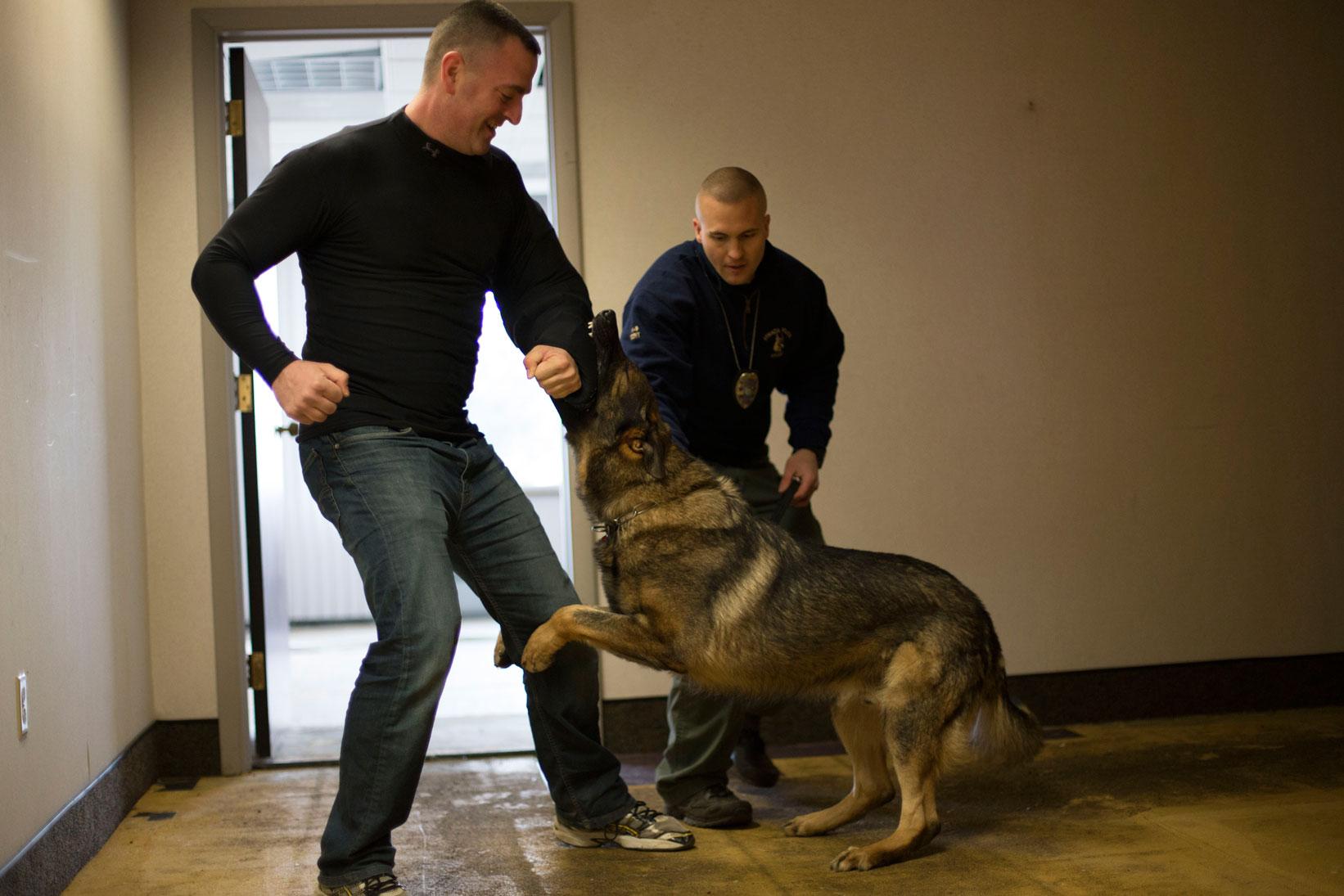
In this training exercise March 28, Officer Jordan Papkov struggles with Bert, who has bitten into the officer’s arm guard. Bert has been trained to aid arrests by immobilizing suspects.
“Help me,” the voice grunts. “The dog’s got me.”
Kimmich pushes open the door and walks into the room. It’s empty, with wooden floors and one window streaming in bright, afternoon sun. In the rays, like a spotlight, Officer Jordan Papkov is hunched over, flailing the 93-pound shepherd, which hangs by its teeth off the padded bite-sleeve on his forearm. Bert’s feet, all four of them, leave the ground with each pull, trailing behind him as if accessories for his powerful, locked jaws.
“Gah,” Papkov says, a bead of sweat hanging precariously off the tip of his nose. He looks at Kimmich with a strained smile. “Yeah, that’s a good bite.”
Bert will not let go. Although this is only a training scenario, the dog does not hold back, and even Papkov, standing over 6-feet tall, cannot shake off these powerful jaws. The struggle only ends when Bert inevitably “slips the sleeve” and pulls the bite guard off of Papkov’s arm, parading around the room with his trophy between his jaws.
Then they do it again. Each time, the same outcome: Papkov never shakes the dog. The sleeve always comes off, and Bert always finds his target.
[acf field=”code2″]
Bert the Protector
This is the other dimension of Bert. While he can gleefully welcome the many patting hands of curious children, he also must fulfill his role as a law enforcement tool.
And he does. Bert is quite literally a rare animal. He is a dual-purpose K-9 unit, the only one of his kind in the county, and is gifted with the ability to sniff out both explosives and firearms, while also offering his skills in the realm of disturbance tracking: A method of pursuit that doesn’t use the dog’s sense of smell, but its eyes. Bert has been trained to be cognizant of disturbances, like footprints, broken sticks or toppled objects, for instance, and follows those cues in his pursuit of an individual.
“Let’s say, as you’re walking, you’re going to scuff up leaves, or grass or stones or mud,” Kimmich said. “Whatever it is that’s getting disturbed, that’s what the dog is alerting to.”
Then, of course, there is his other skill: apprehension, shown with startling clarity as he clamped his jaws around Papkov’s arm. Cannon-like and with impressive agility, Bert can channel all 93 pounds of his body into his 42 teeth, thus he is fully capable of taking down targets far larger than himself. Papkov said even he, strongly built and standing over 6-feet tall, has found himself on the ground at the will of Bert’s jaws. However, despite occasionally being on this receiving end, he said the sense of safety Bert offers with these skills is something that is constantly appreciated by him and the officers.
[block] Bert can channel all 93 pounds of his body into his 42 teeth, thus he is fully capable of taking down targets far larger than himself. [/block]
“You feel safer,” Papkov said. “If something does happen, if someone comes out, the dog will definitely protect the officers involved. I definitely think it is a positive officer-safety tool that we use … We’re definitely proud and happy to have him on our shift.”
Despite what pain he is capable of inflicting, Kimmich is quick to note that Bert isn’t trained to kill. He has been trained to immobilize, holding onto his target like a living anchor until they can be subdued. In this state, he can be flailed, tossed and swung — he does not waver. Bert, with all his might, remains, serving as what Kimmich sees as one of the force’s most potent, non-lethal methods of taking down a suspect.
“All this crazy, goofy-looking gear that we have, all the tasers and the pepper spray, he’s equal to that,” Kimmich said.
Acting as a sentient tool, Bert can search, he can scour, he can infiltrate, he can detain, he can track — a breathing Swiss Army Knife, wrapped in a coat of fur and infinitely ready, all without endangering an officer. This notion, Kimmich said, takes some edge off of the ever-present, potential danger of the job.
“We’ve had officer-involved shootings,” Kimmich said. For a moment, he seems suddenly exhausted.
“We’re going home at night, and the dogs are going to help us do that,” he said. “Is it a guarantee? Absolutely not, it’s another tool, but it does make us safer.”
Car Paws
Often, during their patrols together, Kimmich calls Bert “Bigfoot,” and looking at Bert’s massive paws hanging over the sill of his car-kennel’s window, it’s easy to see why. Each paw, as wide as a fist, hangs limply, bobbing up and down as Kimmich navigates Ithaca’s rampant, yawning potholes. Often, whenever Bert feels so inclined, he will thrust himself into the front seat, forcing his massive, furred head upon Kimmich, licking his face, ears and wherever else he may be able to reach. Any stoic composure is quickly lost, and Kimmich can’t help but laugh at his intrusive, backseat driver.
However, when Kimmich leaves the vehicle, even if just to run back into the station, it takes Bert about 20 seconds before he begins to whimper, pushing his snout against the window and leaving countless wet nose-prints. In this state, he rarely stays still for longer than a minute, though one may be able to catch a glimpse of his face. Flanked by two circles of brown, his eyes dart nervously, checking each window until Kimmich takes his place in the driver’s seat — the officer’s seat — once again.
It seems natural that Bert could miss Kimmich so quickly. The officer will often muse over the dog’s international origins, and with some heartache, will imagine how the young shepherd felt during his transit.
“He was just looking for a buddy when he came back. He was just looking for somebody to bond with,” Kimmich said. “You figure, he’s in Europe for a little while, for God knows how long … So in his little mind, he’s thinking, ‘What am I doing, what is my purpose in life?’”
Then there is that single text message from Myers. The first time Kimmich ever laid eyes on Bert.
“When I saw that picture … the face, and his eyes,” Kimmich said. “You can just see, ‘I want a home.’ ”
[acf field=”code3″]
Purebred
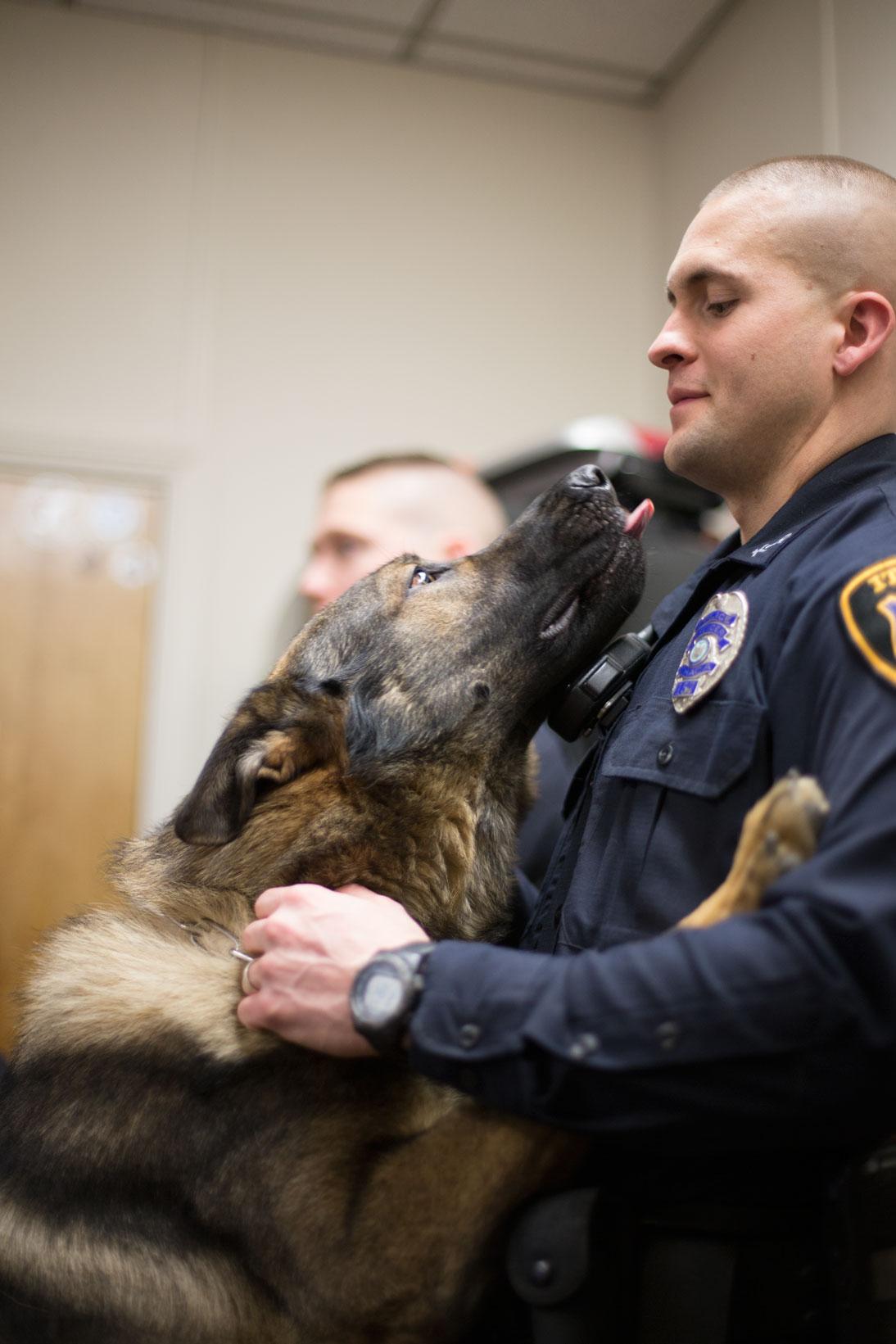
Bert leaps up to lick Kimmich’s face during a briefing March 28. While in the station, Bert
accompanies Kimmich at all times, joining him for briefings and saying hello to fellow officers.
Bert will, ultimately, be a few things to many people. For some — surely an unlucky few — he will be a furry, toothed dart. A 93-pound, four-legged embodiment of looming justice, armed with two golden eyes and a mouthful of ivory-white teeth.
For others, he is a protector, selfless and driven, striving to mitigate the risks that come with fighting crime. Worthy of being sworn in. Worthy of some form of true, human honor.
For Kimmich, however, Bert is, and will likely always be, something more complex: a bridge to the community, a friend, a partner. He’s a pair of ears in the rear-view and welcome company. A sleeping, yet never entirely asleep, bundle of sable-colored fur, curled up in the back, waiting for him, waiting for duty, wherever it may be.
As he runs his hands through the scruff of Bert’s neck, the dog’s head poking in from the back, Kimmich recalls the moments where his K-9 came through as an asset to the force, be it the echoes of his barks through an abandoned plant, or simply the camaraderie he offers to his fellow officers. These things considered, Kimmich can’t help but thank this dog, even though, in the end, Bert demands no thanks.
“I seriously, afterwards, have gotten into the car, and as he’s popping his head through. I’m like ‘Thanks man, thank you,’” Kimmich said. “‘You’re awesome, this is why I love you.’”


